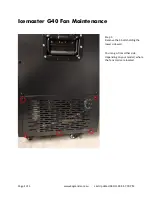
126
RTAA-SVX01A-EN
Refrigerant Charging and Recovery
10.
Open all valves, start the unit and verify the refrigerant charge by
measuring the subcooling.
High Side Repair
If the refrigerant needs to be isolated in the low side of the unit, perform the
following procedures:
1.
Press the STOP key and send the unit through a stopping mode.
2.
Close the discharge service valve.
3.
Before closing the liquid line service valve, attach a manifold gauge set to
the liquid line valve backseat port.
4.
Close the liquid line service valve.
5.
Attach the inlet of a liquid transfer pump to the manifold gauge set and
the outlet to the 1/4” angle valve, located between the EXV and the evap-
orator. This will transfer the liquid refrigerant.
6.
Remove the liquid transfer pump. Attach the inlet of a recovery system to
the manifold gauge set and the outlet to the 1/4” angle valve, located
between the EXV and the evaporator. Remove all of the vapor from the
high side of the system.
7.
Complete all necessary repairs.
8.
Evacuate the high side through the access port on the liquid line service
valve that has the manifold gauge set attached to it.
9.
Open all of the valves and run the unit. Verify the refrigerant charge by
measuring the subcooling and monitor the sightglass.
Adding Refrigerant
If the entire charge has been removed, perform the following procedures to
recharge the unit:
1.
Open all service valves.
2.
Establish water flow through the evaporator. Connect a hose from the
refrigerant bottle to the backseat port on the liquid line shutoff valve.
Midseat the valve.
CAUTION
Freezing and Rupturing Tubes Damage!
The evaporator water flow needs to be established and
maintained while adjusting the charge to avoid freezing and
rupturing the tubes. Refrigerant pressure below 65 psig can also
cause freezing and rupturing of the evaporator tubes.
3.
It may not be possible to put the entire amount of the refrigerant charge
required using Step 2. If so, start the unit and add liquid refrigerant
through the 1/4” liquid line angle valve between the EXV and the
evaporator.
4.
Once the unit has been charged with refrigerant, start the unit. Measure
the subcooling and monitor the sightglass to verify that the refrigerant
charge is correct.
Summary of Contents for RTAA-100
Page 110: ...110 RTAA SVX01A EN Start Up Procedures Figure 37 Unit Sequence of Operation...
Page 143: ...RTAA SVX01A EN 143 Pump Package Figure 47 Pump Package Piping Schematic...
Page 144: ...144 RTAA SVX01A EN Pump Package...
Page 146: ...146 RTAA SVX01A EN 3327...
Page 147: ...RTAA SVX01A EN 147...
Page 148: ...148 RTAA SVX01A EN 3328...
Page 149: ...RTAA SVX01A EN 149...
Page 150: ...150 RTAA SVX01A EN 6516...
Page 151: ...RTAA SVX01A EN 151...
Page 152: ...152 RTAA SVX01A EN 3329...
Page 153: ...RTAA SVX01A EN 153...
Page 154: ...154 RTAA SVX01A EN 6472...
Page 155: ...RTAA SVX01A EN 155...
Page 156: ...RTAA SVX01A EN 156 3330...
Page 157: ...157 RTAA SVX01A EN...
Page 158: ...158 RTAA SVX01A EN 6046...
Page 159: ...RTAA SVX01A EN 159...
Page 160: ...160 RTAA SVX01A EN 3331...
Page 161: ...RTAA SVX01A EN 161...
Page 162: ...162 RTAA SVX01A EN 6519...
Page 163: ...RTAA SVX01A EN 163...
Page 164: ...164 RTAA SVX01A EN 6047...
Page 165: ...RTAA SVX01A EN 165...
Page 166: ...166 RTAA SVX01A EN 3325...
Page 167: ...RTAA SVX01A EN 167...
Page 168: ...168 RTAA SVX01A EN 6048...
Page 169: ...RTAA SVX01A EN 169...
Page 172: ...172 RTAA SVX01A EN 3326...
Page 173: ...RTAA SVX01A EN 173...
Page 174: ...174 RTAA SVX01A EN 6049...
Page 175: ...RTAA SVX01A EN 175...
Page 176: ...176 RTAA SVX01A EN 6463...
Page 177: ......
















































